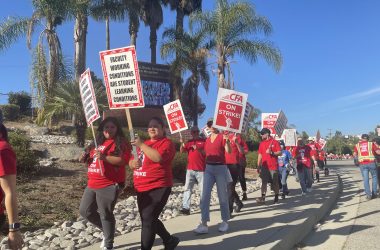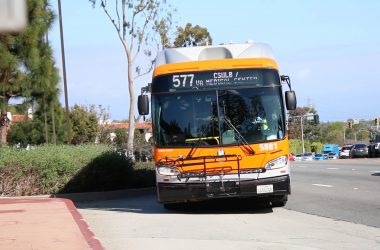This is the second of a two-part report on a faculty ethnic diversity conference at Cal State Long Beach on April 24. Read part one here
When James Manseau Sauceda attended Cal State Long Beach as a student, finding faculty with similar ethnic and cultural experiences was out of the question.
“As a student in the 1970s, you really felt, ‘Do I belong here?’ [CSULB] was a white institution … it was intimidating,” Manseau Sauceda said at a recent conference in CSULB’s Karl Anatol Center. The seminar, organized by Chicano-Latino studies (CHLS) professor Victor Rodriguez and sponsored by the College of Liberal Arts, was geared toward putting a new face on what seems to be a lack of diversity among faculty in the California State University system.
Manseau Sauceda, now a professor in communication studies and director of CSULB’s Multicultural Center, said increasing the number of minority educators at the university is imperative.
“We haven’t radically altered the environment [since the 1970s]. We can do better,” Suaceda said.
CSULB President F. King Alexander agreed the disparity in minority faculty is a concern and insisted the university will improve.
“It will get better if we actively recruit more intentionally in new, inventive ways,” Alexander said. “The way we’ve done it is not going to cut it. We need to diversify the talent pool.”
CHLS associate professor José Moreno was one of the speakers at the morning-long symposium, along with Daryl Smith, a professor of education and psychology at Claremont Graduate University, and Linda Turner-Bynoe, a California Faculty Association representative of the CSU Council for Affirmative Action.
Moreno’s segment focused on the low numbers of minority faculty in all eight of CSULB’s colleges.
“To turn the research on ourselves is very difficult,” Moreno said, comparing the situation to “organized anarchy.”
In Moreno’s presented data, of the 898 tenured and tenure-track faculty last year, 616 were white, 163 were Asian/Pacific Islander, 62 were Latino, 40 were black, 6 were Native American and 22 were listed as “other.”
Moreno told the audience of approximately 150 students, faculty and administrators, “If you see a black faculty member on campus, take their picture. If you see American Indian or Latino faculty, take their picture. Don’t let them all get on the same elevator because we can’t afford to lose them — they are rare.”
Latino faculty has the most skewed representation compared to the amount of Latino students, according to data presented by Turner-Bynoe.
In her figures, 5,288 Latino students comprised 22 percent of CSULB’s 27,809 total enrollment in 1997. By 2007, 9,430 Latinos accounted for 28 percent of the 36,868 students enrolled, a 10-year spike of 6 percentage points.
According to the fall 2007 university factsheet, of the 901 tenured and tenure-track faculty in 2007, about 7 percent of faculty were Mexican-American or of other Latino descent.
Priscilla Luviano, a senior CHLS major, said she worries about the imbalance.
“I think we’re not being represented. We don’t have teachers to look up to,” Luviano said. “We don’t have enough role models [at CSULB].”
CHLS lecturer Armando Vazquez-Ramos, among the first wave of less than 100 Latino students at CSULB in the late 1960s, said he can relate to any current student frustration.
“We were like a fly in the punch bowl. We were ostracized,” Vazquez-Ramos said of his early university experience. “We had no faculty of color, or at least we didn’t know they were there.
“The Latino student population has grown from 100 to nearly 10,000, yet we [the CHLS Department] barely have eight full faculty members today,” Vazquez-Ramos said.
He blamed not only the university, but his own department for failing to increase the number of Latino faculty.
“Most Latino students who come into my classes for the first time say, ‘Wow, you’re the first Latino professor I’ve seen here [at CSULB],’ ” Vazquez-Ramos said. “That’s not good.”
Referring to CSULB’s designation as a Hispanic Serving Institute, Smith said, “You have to ask your administrators, ‘Is this place really committed, or is it just rhetoric?'”
Rodriguez said students have a responsibility to help change ethnic faculty representation.
“We are living in denial on this campus,” Rodriguez said. “Students will benefit most if this process takes hold and they raise their voices. Classroom discussions will also become much richer [with improved faculty diversity].”
Some students on campus feel that student and faculty diversity changes depending on the department.
“Since I am a fourth-year student, I’ve taken a lot of GE classes and classes in my major, and it’s different for every department,” said Lourdes Alejandrino, a senior radiation therapy major. Alejandrino said her physics professors have been mostly Japanese, a majority of her information systems professors have been Asian, and her Chicano/Latino studies professors were “obviously Hispanic.”
As a graduate student in library science, Jennifer Rossano said she thinks students and faculty are both diverse, but said her graduate classes have been much less diverse than her undergraduate classes.
At the event Moreno cited a high turnover rate as CSULB’s chance to increase faculty diversity.
“What this means in terms of numbers is that we hired 551 [of the current approximately 900] full-time tenure/tenure-track faculty in the last eight years alone. Of our 21st century hires, we turned over about 60 percent,” Moreno said. “The faculty and staff are coming toward the end of a turnover. Many professors have and will be retiring. The time to diversify faculty is now. We need to fight to keep minority faculty.”
Serafina Costanza and Grady Dunne contributed to this article.





It’s mindblowing how some of the colleges are lacking equity. The College of Liberal Arts houses ethnic studies but has an incredibly small number of ethnic faculty, for instance? What’s wrong with you CSULB?
This cannot be the same 49er from the 1950s, 60s and 70s that put it on the line to cover socially important stories. Truly impressive journalism for a change. These youngsters stepped out of the pit on this one. Keep it up.
So many studies should be generated from this series. Investigate the complexion and lack thereof of how the system, both in-house and statewide are impacted by having institutional racism as a stalwart. Who reaches the decision making levels, university administration, the board of trustees, etc. Take a look at the CSU board of trustees and evaluate if that is representative of our structure. This is an important report because it impacts tens of millions of Californians, which can therefore touch the lives of hundreds of millions internationally. I’m extremely surprised that these student reporters took such incentive, knowing they would not be reporting the popular. Nice job to Costanza, Dunne and Rescola. Never give up and never let anybody tell you your journalism dedication is headed in the wrong direction.
I am flabbergasted that I can’t describe the need for this commitment to faculty diversity enrichment better than Misako Miyagawa did. Thanks to all three of these reporters for doing what journalists are supposed to accomplish; finding a trend that impacts our larger society, covering it with in-depth sensitivity and balance, and putting their names on it. Fantastic article and important reporting. As was the results of Upton Sinclair’s hallmark endeavors, this is what news reporting should be. Very good job, as Ms. Miyagawa so eloquently relayed.
I had neglected to also say below that an ethnically and culturally diverse university — at multiple levels embodied and enlightened — is a university that affords its members and community a highly advantageous edge in an increasingly competitive global marketplace. I.e., diversity fluency is an invaluable asset and very much in our individual and national self-interest.
To Serafina, Duke and Grady:
Bravo. I’ve been waiting to read a report on this topic from the moment I first “walked through” the CSULB English Department faculty web page. (English was my major before switching to journalism.) At the time, I was dismayed to see the department’s apparent lack of ethnic diversity. For me, love and respect for my first tongue is no less than an embrace of our country’s collective history and culture, which have been inextricably influenced and shaped by the very richness of our varying ethnic origins, perspectives and experiences from without, within and into that shared common culture.
So, as I took in what I has seen on the English Department’s faculty list, I wondered why such a disparity existed, and on a campus whose mission statement includes the following:
“A fundamental goal of all of the University’s programs is to prepare students to function effectively in a culturally diverse society, by developing an understanding of our diverse heritage, including the essential contributions of women and ethnic minorities. Instruction emphasizes the ethical and social dimensions of all disciplines, as well as their applications to contemporary world issues. Building upon the culturally diverse region it serves and the international character of its faculty, the University emphasizes international education in its curriculum.”
That said, you’ve done a terrific job in your in-depth reporting on this very relevant issue, and I thank you for it. As a Japanese-American, I don’t necessarily look for “my own” to head a classroom, so much as I desire and expect to see a broad spectrum of faculty in general — one which reflects the strength and intellectual, multi-cultural dynamism of our region and state.
To have the most professionally qualified scholars and educators in our university classrooms is a privilege. To NOT have individuals, among such faculty, whose backgrounds speak implicitly, if not explicitly, to that fertile cultural dynamism is an incalculable loss. Diversity is not an optional buzz word. It is a living, potent treasure of humanity and democracy at their most enlightened. EVERYONE is vastly enriched and invigorated by such diversity in and at the head of the classroom and beyond. And each of us is impoverished by its absence; worse, by our neglect to work together to change it.
I am therefore glad to read that CSULB administration has, in the face of quantitative evidence, acknowledged the disparity gap. Moreover, that the issue is not a two-dimensional one, but a critical one that requires more assertive, thoughtful leadership — at all levels on the CSULB campus and throughout the CSU system — so as to cooperatively address and implement positive, measurable improvement.
Such change is never easy. But commitment to that end is absolutely necessary. And its fulfillment absolutely possible. Let us hope that last week’s symposium and your reporting on it have helped CSULB take a vital next step in that direction.
This only proves what everybody already knew-white people are smarter and reach higher plateaus in education.
Our university could improve, but we’re in a troubled economy. I’m glad the story points out that this is no just administration’s problem, but belongs to the entire learning community. Hiring committees need to stop building walls to keep out talented candidates because of petty nuances or peeves. Students need to communicate in the classrooms and to their student government and administrators that they perceive an uncomfortable atmosphere. Faculty not on hiring committees need to express concerns of diversity and the working environment to their departments, who should listen proactively with open ears and minds. None of these inequities will be solved without more open dialogue. This story was very well done, 49er.